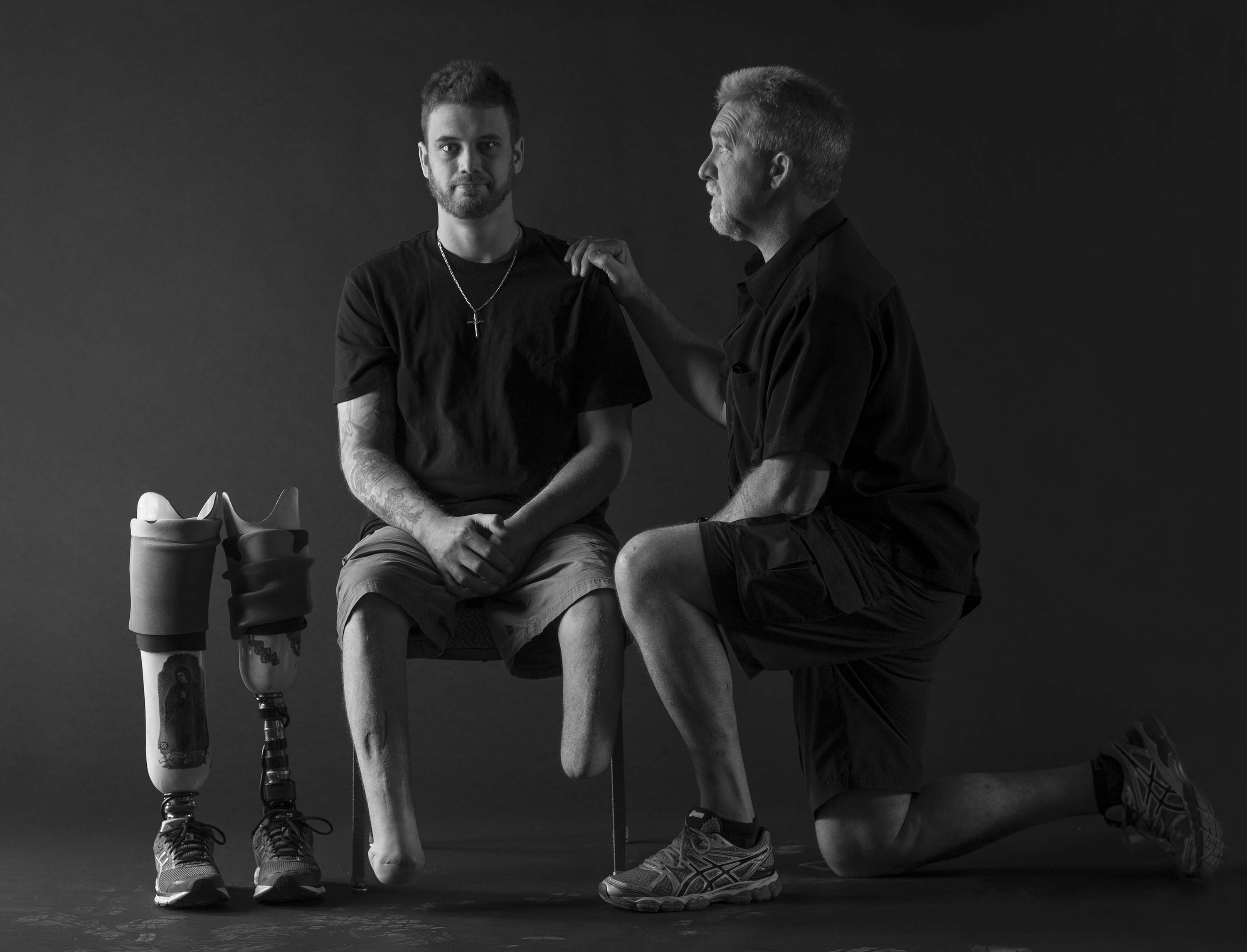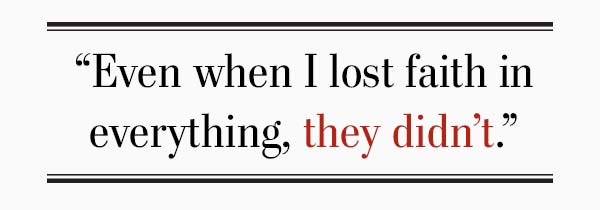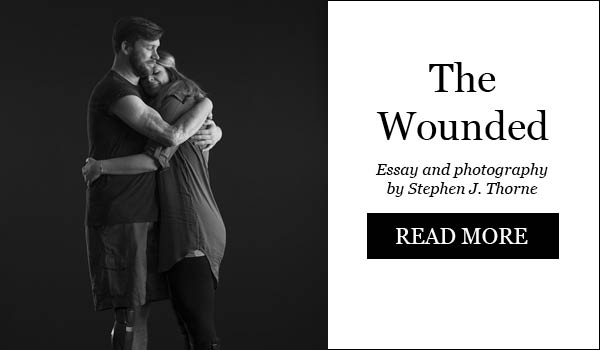
PORTRAIT OF INSPIRATION
André and Martin Renaud fought together, then healed together
Story and photography by Stephen J. Thorne
They’re father and son, and brothers in arms.
André and Martin Renaud share a bond forged not just by birth, but as soldiers on the field of battle.
Both members of the Royal 22nd Regiment, they were deployed together to Afghanistan in 2007. They had even worked out of the same forward operating base east of Kandahar and had been on at least one combat operation together.
Master Warrant Officer André Renaud, a native of Saint-Raymond, Que., was a seasoned paratrooper working with combat engineers conducting forensic examinations of bombing incidents—until Nov. 27, 2007, when one of those bombs took out his 19-year-old son.
André was about 15 kilometres away when it happened. It was a big blast.
“I heard the explosion and I felt the shockwave,” he says.
He knew Martin was out there somewhere, but he had no thoughts that it was his son who had been hit. Duty called, and he went right to work.

Continued from Military Health Matters e-report No. 28
André is fiercely proud of his boy. He had signed the papers when Martin joined the Vandoos’ 3rd Battalion at 17. Martin followed in his father’s footsteps and became a paratrooper.
“I was proud he joined,” says André, 55 and retired after 35 years of service. “I was proud he shared the values of the Canadian infantry, proud he was establishing a family tradition of service.”
Afghanistan was Martin’s first overseas deployment.
André was part of a team investigating blasts of mines, booby traps and, most commonly, improvised explosive devices (IEDs). He had conducted about a dozen such investigations before Martin’s incident.
In fact, André literally wrote the book on counter-IED measures and procedures, and he had trained the troops in how to apply them. Martin’s platoon was following the inverted-V formation that his father had developed when he was hit.
The two had shared meals whenever they could. Martin was constantly on the move from one forward operating base to another. They had been together at Ma’sum Ghar until the night before the incident, when André last saw his son in one piece, standing in the turret of his light armoured vehicle (LAV) doing a radio check.
André’s job afforded him the ability to assess all three elements of the battle group, and he had concluded that Martin’s company was the most engaged and aggressive. There had been more IED blasts, more enemy contact and more firefights in their area of responsibility than those of the other elements.
“I worried about him constantly,” says André.
The young private had been out all night on patrol after he had last seen his father. They had arrived back at the forward operating base only to be sent back out as a quick reaction force to take over a police strongpoint from another platoon.
Martin never got there.
He was manning communications in the first vehicle out when a report came in of a suspected IED. He stayed in the vehicle while troops took to the ground, forming the inverted-V as they walked it. They gave his crew the thumbs-up. All clear.
There were four of them in the LAV-3 as it began moving forward—the commander, the driver, Martin and Private Dominic Larocque. It was 9:50 a.m.
They didn’t get far. They passed directly over the pressure plate that triggered the IED. André would later recognize the local maker’s signature: a pressure cooker fitted with a detonator and packed tightly with homemade explosive made from diesel fuel and 20 kilograms of fertilizer. It was buried almost two metres deep.
The device blew a crater 20 metres in diameter, driving the LAV’s transmission up through seven centimetres of steel and 2.5 centimetres of ceramic plate, creating a hole 76 centimetres wide in the bottom of the crew compartment.
Larocque was thrown out and badly wounded. The other two also survived, with relatively minor wounds, the driver still in his cockpit and the commander thrown clear.
Martin smashed his helmeted head against the ceiling and, as the pressure outside the vehicle dissipated, the rapidly expanding gases inside escaped back out through the hole, partially sucking him along with them. He ended up jammed in the hole itself, folded double—backwards. His shattered, shredded legs were behind his head and his back was broken.
The shockwave travelled at 3,200 metres per second, almost 10 times the speed of sound. It reached André back in Ma’sum Ghar in less than five seconds, followed by a distinctive crack. He immediately ordered his team into action. Then he headed to the command post to get his orders.
“The duty officer told me, ‘Get your team on the QRF [quick reaction force] but you, personally, have to stay here,’” he recalls. “At that point, I didn’t know why.”
Back at the scene, equipment and parts had come crashing down on top of Martin. It took rescuers a minute to find him. He was conscious and shouting “Airborne!” over and over again even as the others got him into another vehicle.
Both his femoral arteries had been severed. Tourniquets, and Martin’s physical conditioning, saved him from dying at the scene. Doctors credited his abdominal muscles for preventing his spinal cord from rupturing under the tremendous strain.
By 10:10, Martin was back in Ma’sum Ghar, where an evacuation helicopter was waiting to take the wounded to the field hospital at Kandahar airfield.
It was only then, when they knew he had reached safe haven within the critical first “golden hour,” that André got a call on the field phone from Martin’s company sergeant-major. He told him his son would be all right, that he was still alive and still screaming “Airborne” right up until he was loaded on the Blackhawk.
André’s legs went out from under him at the news. The duty officer helped him up from the floor and guided him to a chair.
“The first thing I thought was, ‘What time is it in Quebec City?’ I had to call my wife.”
He waited hours, until 6 a.m. Quebec time, or 3:30 p.m. in Afghanistan, to make the call, getting updates on his son’s condition all the while. He called his mother Margot first, asking her to go to his wife Lena before he broke the news to her.
At this point, he knew only that one of Martin’s legs was severely damaged in the blast. He didn’t know his back had been broken or that his other leg was badly wounded too.
Meanwhile, his investigative team returned with Martin’s LAV on a flatbed trailer, headed for Kandahar. The half-tonne back door and two left-rear wheels were gone; the interior was damaged and blackened by fire. It had the distinctive stench of the vehicle’s chemical fire-retardant.
On arrival at the field hospital, he saw Larocque on his way to the recovery room after losing a leg in surgery. At 10 p.m., almost 12 hours after the blast, he saw his son. Martin was in a coma and virtually unrecognizable.
“There were iron rods coming out of him everywhere,” André recalls. “His face was all swollen.”
At one point, Martin and Larocque were lying side-by-side in the recovery room. André breaks down as he describes how Larocque was giving his unconscious crewmate a pep talk, despite the fact he had just lost his own leg.
“Wake up, man,” Larocque was saying. “We’re going home!”
“The guy is right out of surgery,” says André. “He’s just lost a leg, and he knows it.
“Incroyable.”

Some 48 hours later, the three of them—André, Martin and Larocque—got on a plane to Landstuhl, Germany, via Kuwait and Iraq. The American aircrew placed a Canadian flag next to them as they left Kandahar. In Kuwait, they changed crews and in Iraq they refuelled and picked up an American infantry company.
The plane was divided into sections, with the Canadians up front. In a moving gesture of solidarity between soldiers of different nations, the infantry commander came forward and asked André for permission to bring his boys ahead to say a prayer for the two wounded Canadians.
“So, all the Americans came up and stood around Martin and Dominic and prayed.”
Landstuhl is home to the largest military hospital outside the United States. It is run by the Americans and is a waypoint for the seriously wounded from battle zones all over Central Asia, the Middle East and Africa, often their first opportunity to receive complete assessments and treatment beyond a field hospital.
That is where a doctor took André aside and asked permission to amputate his son’s leg at the hip. André got a Canadian liaison officer to call the physician who had operated on Martin in Kandahar. The doctor told him not to sign the document and wait for microsurgery specialists in Quebec City to have a look.
They stabilized Martin’s spine and began easing him off the meds that were keeping him in the coma. By the time he woke up, his mom and sister were there in Germany to greet him.
André was out of the room. When he returned, the first words out of Martin’s mouth were: “Dad, get my gun and my boots. They need me back there.”
On the flight home, a Canadian special forces soldier who had worked with Martin told him: “If you can eat, you’ll survive. If not, you’ll die.” That was all the incentive Martin needed; he loaded up on chicken wings the whole trip back.
They arrived in Quebec on Dec. 6. Soon after, doctors amputated Martin’s right leg just above the ankle.
He would wage a titanic battle against life-threatening bacteria for two years, struggling to save his left leg. With the infection spreading upward and a blood clot forming, he finally lost it just below the knee in 2009, a devastating blow.
His family, always close, lived and fought every stage of the battle with him.
“Even though it was Martin who was injured, the whole family felt the effects of his injuries,” says his father. “Those consequences are still alive today.”
He battled for three more years to stay in the army, learning to walk with prosthetics and struggling with lingering psychological trauma. He was finally shown the door after he couldn’t make a required 13-kilometre ruck march.
“At one point, Martin was the poster child for everything that was wrong with the system at that time,” his father says. Martin appeared before a Senate committee at age 21, testifying about his difficulties with the military and Veterans Affairs.
Martin and his father say they’ve seen a big change in the way veterans are perceived and the quality of service in recent years, and both father and son say they’re thankful to the army for all it did to get Martin walking again.
Larocque, a single-amputee, continued his military career and went on to sledge hockey stardom.
André and Martin Renaud are as close as a father and son can be. They don’t attend regimental activities, where they’re inevitably compelled to relive their experience. Instead, they go hunting and fishing together.
“We don’t have to talk about it,” says André. “We know it.”
“There are guys in the military with fruit salad [medals] on their chests, counting how many tours they did,” he adds. “But for us, the tour has never ended. Part of us is still over there. It will never be over. It will never be the same.”
Now 29, a lot has changed for Martin Renaud, inside as well as out.
“I’m a better person now,” he says. “All the injuries and all that happened made me appreciate what I do have. I listen more, talk less. I’m much more mature. I wish I could’ve learned these things, this wisdom, the easy way.”
He credits his family, especially his father, with his very survival.
“If I’m standing here now, it’s because of them,” he says. “Even when I lost faith in everything, they didn’t. And, because of them, I came through.”
André has seen his son grow from the day he was born, and the day he was reborn. He was there for every fall, for every milestone, for all of it.
“To me,” he says, “Martin is, of course, a son and a friend, but he’s also a brother in arms. We literally fought the enemy together, and I will never let him down.”
To view more images and read other instalments in Stephen J. Thorne’s Portrait of Inspiration project for Legion Magazine, please click below.

Advertisement












